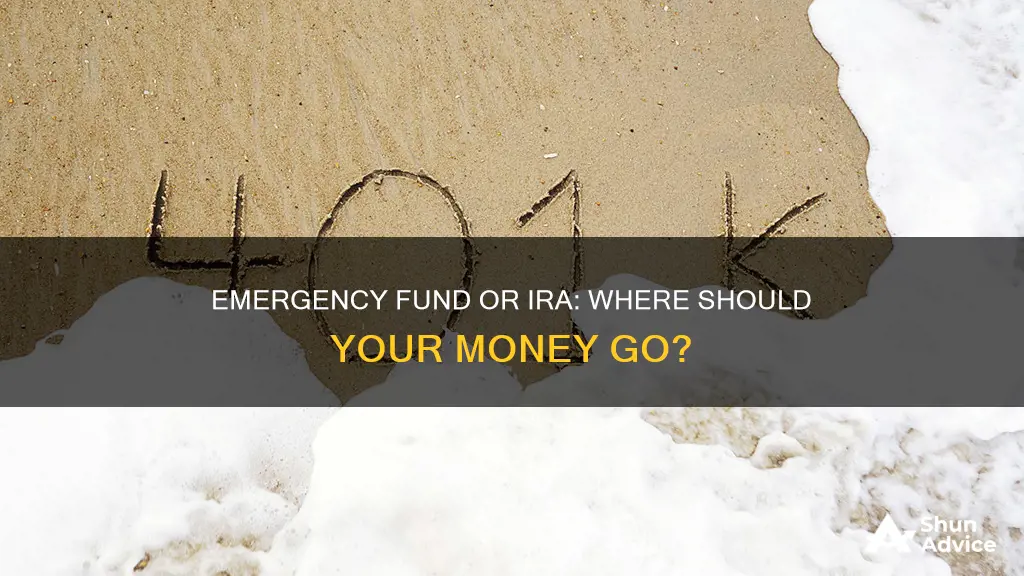
Building an emergency fund is an essential part of financial planning. While investing in an IRA is a great way to build wealth over time, it's crucial to have a financial cushion in case of unexpected expenses. Here's why you should prioritize building an emergency fund before investing in an IRA.
| Characteristics | Values |
|---|---|
| Should you invest your emergency fund? | No, it is not wise to invest your emergency fund in the stock market or other high-risk investments. |
| Why do you need an emergency fund? | To cover unexpected costs, such as periods of unemployment or a temporary drop in income. |
| How much should you save in an emergency fund? | Typically, it is recommended to save three to six months' worth of essential living expenses, but some experts suggest saving up to a year's worth. |
| Where should you keep your emergency fund? | In a high-yield savings account, money market account, or certificate of deposit (CD). |
| What is a Roth IRA? | A retirement account that allows you to contribute after-tax dollars and withdraw contributions tax- and penalty-free at any time. |
| Can a Roth IRA be used as an emergency fund? | Yes, but it is generally not recommended unless it is a last resort, as you may lose out on potential investment gains and there are annual contribution caps. |
What You'll Learn

The benefits of having an emergency fund
An emergency fund is a crucial component of financial planning and offers numerous advantages beyond simply providing financial stability. Here are some of the key benefits:
- Peace of mind and reduced stress: Knowing you have a financial safety net in place gives you the confidence to handle unexpected events without adding money worries to your list.
- Avoiding bad financial decisions: An emergency fund prevents you from making impulsive or desperate financial choices. Without an emergency fund, you may be forced to rely on high-interest credit cards, take out loans, or dip into your retirement savings, all of which can lead to long-term financial setbacks.
- Maintaining financial stability: An emergency fund helps you recover quickly from financial shocks, whether minor or major. It ensures that you don't fall into debt or deplete your retirement funds to cover unexpected expenses.
- Easy access to funds: By keeping your emergency fund in a savings account or other liquid assets, you can easily access your money when needed. This is especially important during emergencies when time may be of the essence.
- Avoiding investment risks: Investing your emergency fund in the stock market or other high-risk ventures can expose you to potential losses and make it difficult to access your money when needed. Keeping your emergency fund separate from investments ensures it is readily available.
- Discouraging unnecessary spending: Setting up a separate emergency fund account helps you keep track of your savings and discourages you from spending the money on non-essential purchases.
- Achieving financial goals: Building an emergency fund encourages good financial habits, such as saving consistently and monitoring your progress. These habits can help you achieve not only your short-term financial goals but also your long-term ones.
In summary, having an emergency fund is a crucial aspect of financial planning. It provides security, reduces stress, and helps you make better financial decisions. By setting aside money for unexpected expenses, you can protect yourself from financial setbacks and work towards achieving your financial goals.
Savings Strategy: Mutual Funds Investment Allocation
You may want to see also

The risks of investing in the stock market without an emergency fund
Investing in the stock market without an emergency fund can be risky. Here are some of the dangers:
Potential Loss of Investment
If you invest your money in the stock market without an emergency fund, you run the risk of losing your initial investment if the value of your assets falls. The stock market is unpredictable, and there is always the possibility of a market downturn or crash. If an emergency arises during a market low, you may be forced to sell your stocks at a loss to cover the unexpected expense.
Difficulty in Accessing Funds
Emergency funds are typically kept in accounts that allow for easy and quick access to funds, such as savings or checking accounts. In contrast, investments in the stock market may be more challenging to liquidate, especially if you need immediate access to cash. Selling stocks can take several days, and there may be penalties or taxes associated with early withdrawals, further reducing the value of your investment.
Missed Opportunities for Long-Term Growth
While keeping all your money in a bank account may result in missed opportunities for retirement account contributions and long-term wealth growth, investing without an emergency fund can also lead to missed opportunities. If you are forced to sell your stocks at a loss to cover an emergency, you miss out on the potential for those stocks to recover and grow in value over time.
High-Interest Debt
Without an emergency fund, you may be forced to rely on credit cards or loans to cover unexpected expenses. Credit cards often come with high-interest rates, and you may end up paying significant amounts of money in interest charges. This can create a cycle of debt that is difficult to escape.
Tax Consequences
If you invest in a taxable brokerage account and need to sell your stocks to cover an emergency, you will be responsible for paying taxes on any gains. If you have held the stocks for less than a year, you will likely pay a higher short-term capital gains tax rate, resulting in further losses.
In summary, investing in the stock market without an adequate emergency fund can lead to potential losses, difficulty accessing funds, missed opportunities, high-interest debt, and unexpected tax consequences. It is generally recommended to have an emergency fund equivalent to three to six months' worth of essential living expenses to provide a financial cushion and allow for more flexibility in your investment strategies.
Angel Broking: Your Mutual Fund Investment Guide
You may want to see also

How to save for an emergency fund
Building an emergency fund is a crucial part of financial planning. This fund can help you cover unexpected costs, such as medical bills, car repairs, or unemployment, without having to rely on high-interest credit cards or loans. Here are some detailed and direct steps to help you save for an emergency fund:
Determine Your Monthly Expenses:
The first step is to calculate your monthly expenses. Identify the essential costs, such as housing, transportation, utilities, food, and any debt or credit card payments. Multiply your total monthly expenses by the number of months you want to cover, usually between three to six months' worth of expenses. This calculation will give you a savings goal to work towards.
Set Realistic Savings Goals:
Start with small, achievable goals. You might aim to save $5 or $10 a day, or set an initial target of $500 to $1,000, which can cover minor emergencies. Gradually increase your savings over time. Remember, consistency is key, so try to save regularly, even if it's a small amount.
Create a Separate Savings Account:
Open a dedicated savings account specifically for your emergency fund, separate from your daily spending account. Shop around for a financial institution that offers a decent interest rate and low fees. This account should be easily accessible in case of emergencies, but separate enough to prevent impulsive spending.
Automate Your Savings:
Treat your emergency fund contributions like a bill. Set up automatic deposits or direct deposits into your savings account, so you save effortlessly without having to remind yourself to transfer funds manually.
Funnel Extra Money:
Whenever you receive unexpected income, such as a tax refund, bonus, or cash gifts, allocate a portion of it to boost your emergency fund. You can also use this strategy with any extra money you free up by paying off debts, such as credit cards or loans.
Increase Income and Cut Expenses:
Consider ways to bring in extra money, such as through a side hustle or selling unwanted items. Additionally, review your budget and expenses regularly to identify areas where you can cut back, such as dining out, subscription services, or non-essential memberships.
Stick to Using the Fund for Emergencies:
It's important to use your emergency fund only for genuine emergencies. While it may be tempting to dip into it for non-essential purchases, remember that it's there to provide financial security during unexpected difficulties.
Building an emergency fund requires discipline and time, but it will give you peace of mind and help you navigate life's financial challenges.
Index Funds in Sweden: A Guide to Getting Started
You may want to see also

The advantages of a Roth IRA
It is generally recommended to build an emergency fund before investing in an IRA. This is because IRAs are often difficult to access and come with financial penalties for early withdrawal.
Now, here are the advantages of a Roth IRA:
Tax-free growth
Money in a Roth IRA grows tax-free, so you don't need to worry about reporting investment earnings when you file your taxes. In contrast, if you invest in a non-retirement account, your earnings are subject to federal, state, and local taxes each year.
Tax-free withdrawals in retirement
If you're age 59½ or older and have owned your account for at least 5 years, you can withdraw money from your Roth IRA without paying any penalties or taxes. So, even if you take a lump-sum withdrawal in retirement, your retirement income won't be affected.
No lifetime required minimum distribution
Unlike a traditional IRA, a Roth IRA does not require you to take lifetime minimum distributions. You can take tax-free and penalty-free early withdrawals on what you've contributed at any time. However, if you're under age 59½ and you withdraw earnings on your contributions, you may be subject to taxes and withdrawal penalties on that amount.
Your beneficiaries won't be taxed
The people who inherit your Roth IRA will have to take RMDs (required minimum distributions), but they won't have to pay any federal income tax on their withdrawals as long as the account has been open for at least 5 years.
No income taxes for inherited Roth IRAs
If you pass your Roth IRA onto your heirs, their withdrawals of contributions are tax-free. Earnings from an inherited Roth IRA are generally tax-free; however, they may be subject to income tax if the Roth account is less than 5 years old at the time of the withdrawal.
No contribution age restrictions
You can contribute to a Roth IRA at any age, as long as you have a qualifying earned income.
Hedge against future tax hikes
While there's no way to know for sure if tax rates will rise in the future, a Roth IRA may make sense if you think they might.
Venture Capital Funds: Smart Investment for Future Growth
You may want to see also

The risks of using a Roth IRA as an emergency fund
While a Roth IRA can be used as an emergency fund, there are several risks to this approach. Firstly, it may negatively impact your retirement savings. Withdrawing funds early, even if it's just your contributions, can hinder the compound growth potential of your account. The money you withdraw today could have grown significantly by the time you retire.
Secondly, there are potential tax penalties involved. While contributions can be withdrawn tax-free, earnings withdrawn before the age of 59 1/2 will generally incur a 10% penalty in addition to regular taxes.
Thirdly, you may miss out on market opportunities. If you sell investments during a market downturn, you could miss out on potential rebounds and significant gains when the market recovers.
Another risk is that withdrawing funds from a Roth IRA can be complex and time-consuming, especially if the funds are invested in stocks or other assets that need to be sold and converted to cash. This could cause delays in accessing your money when you need it.
Finally, using a Roth IRA as an emergency fund may compromise your long-term investment strategy. It is generally recommended to keep emergency funds in a separate, more liquid account that is easily accessible in case of unexpected expenses.
In conclusion, while a Roth IRA can provide tax benefits and investment growth potential, using it as an emergency fund carries several risks that could affect your financial future. It is important to carefully consider these risks and explore alternative emergency savings options before making any decisions.
Debt Fund Investment: Choosing the Right Option
You may want to see also
Frequently asked questions
Yes, it is recommended to build an emergency fund before investing in an IRA. This is because if you put your money into high-risk investments, such as the stock market, you are exposing yourself to potential losses and difficulty in accessing your money. An emergency fund ensures that when you're ready to invest, you're doing so with money you can afford to put on the line.
It is recommended that you put aside the equivalent of three to six months' worth of expenses in a liquid account that you can easily access if needed.
An emergency fund provides peace of mind and can help you get through unexpected financial difficulties without having to rely on credit cards or loans.
If you invest your emergency fund in the stock market or other high-risk investments, you run the risk of losing money and sacrificing liquidity. If you need to withdraw your money due to an emergency, you may be forced to sell your stocks at a loss.
While it is possible to use your Roth IRA as an emergency fund, especially if you are only withdrawing contributions and not earnings, it is generally not recommended. This is because you will lose out on the compounding potential of that money, and you may not be able to pay yourself back due to annual contribution caps.







